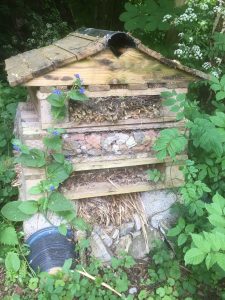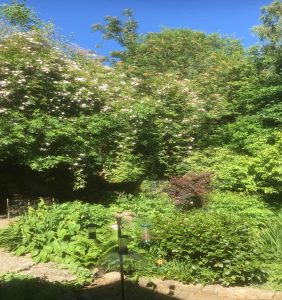Key Actions to Tackle the Climate Emergency and Biodiversity Crisis: Everyone Can Make a Difference – by John Box
“No one is too small to make a difference”. We must all play a part in tackling climate change. Another ten years of incremental changes will not tackle the inter-related climate and biodiversity crises. We have to create hope. Hope is created by actions.
Each month over the next year try one of these twelve ideas for actions
- Using less oil, gas and coal is the most vital action we can all take. These fossil fuels were formed over millions of years from dead plants and animals, are not renewable and burning them generates CO2. Green energy sources – the wind, the sun and the tides – generate no CO2 emissions once operational and are renewable. Try to cut down on using gas and switch to a green energy supplier for electricity if that’s feasible.
- Simple carbon calculators are online to work out your own carbon footprint. Aim to reduce or eliminate your main sources of CO2.
- Insulating the house starting with the roof spaces and attics will save money each year on heating costs and reduce CO2 There’s lots of advice available online.
- Gardens with lots of bushes and shrubs and trees are much shadier and cooler. Think about how refreshing woodlands are. Allow gardens to grow upwards to create cool and shady places. Shrubs and trees will also give perches and nesting places for birds and lots of insects for them to feed on. Adding a pond helps to create a cooler microclimate and provides water and habitats for frogs, newts and dragonflies. Window boxes full of luxuriant flowers will do their bit for absorbing CO2, will brighten up houses and attract butterflies. All of these will absorb more carbon and get more wildlife into your garden.

Gardens with shrubs and trees make cool and shady places to sit. Photo credit John Box.
- Make your own compost. Compost heaps are good for dealing with all the garden cuttings and weedings. The resultant compost improves soil structure and organic content, especially on sandy or clay soils. Mulching with a layer of compost on the soil at any time of year reduces water loss from the soil in hot weather and is good for the soil. There is more and more compost available that does not contain peat but is made from excellent alternatives. Peat is a wonderful natural resource that stores huge amounts of carbon. Adding peat to compost means that a peatland somewhere is being dug up. If you buy a bag of compost, check that it does not contain peat.
- Microhabitats for minibeasts. Small piles of odd brick ends and stones can be hidden away in the corners of a garden creating ideal places for snails, beetles and all sorts of invertebrates to live and overwinter. Bug houses are great fun to build from odds and ends and can be filled with all sorts of things – short pieces of bamboo, bits of brick, hair brushed from the dog, dried leaves and pinecones, feathers and more to encourage bugs and creepy crawlies.

Odds and ends of brick, stones and broken pottery hidden away in corners make wildlife shelters. Photo credit John Box.

Bug houses are fun to make and provide microhabitats for minibeasts. Photo credit John Box.
7. Eating food, vegetables and fruit grown locally helps support agriculture and the countryside. Food grown in Europe or further afield and flown or shipped here will have a much larger carbon footprint.
8. Volunteer to help CIEEM through its standing committees, national and regional sections, working groups and special interest groups, including the Action 2030 group who focus on addressing the climate emergency and biodiversity crisis. Getting involved locally with practical activities through a wildlife trust or wildlife group will help to improve the capacity of wildlife habitats to absorb CO2, increase their biodiversity and is great fun.

Volunteers planting plugs of Sphagnum moss as part of the restoration from plantation conifers to bog on Fenn’s Moss, part of the Marches Mosses NNR which is the third largest lowland raised bog in the UK. Photo credit Robert Duff.
9. Joining another environmental organisation besides CIEEM is always interesting. Or take out a subscription to British Wildlife, which is such a rich source of up to date articles about natural history, or Conservation Land Management, a great source of information for anyone doing practical work with habitats.
10. Your local councillor, local authority councillor or community councillor are really useful contacts. Can your council do more to reduce its CO2 emissions? Can they do more to help biodiversity?
11. Hopefully your MP supports net zero and green issues. Find out if they do. What are they doing locally to help us all tackle these hot summers? Reach out to them and ask for a meeting. CIEEM has shared some tips on how to engage with politicians.
12. Track down the policies – climate change, biodiversity, sustainability, the environment – of the organisations that you work for and belong to. How do the actions being taken match up? They will be keen to hear ideas of how they can improve their environmental performance.
CIEEM has launched a pledge for climate and nature to encourage action and leadership from ecologists and environmental managers. Pledge to reach net zero by 2030 and create a plan to achieve it. Your pledges all add up to showcase CIEEM members as leaders in addressing the climate emergency and biodiversity crisis. Join those taking the lead and make your pledge here.
If you’re interested in learning more on this topic or what we as environmental professionals can do to help reduce carbon, then come along to our Autumn Conference in November called ‘Delivering a Nature Positive, Carbon Negative Future’.
Click here to find out more and book your tickets
 John Box is a CIEEM Fellow and was President from 2012-2015. John chairs the Action 2030 group which provides challenge and advice to CIEEM on the climate emergency and biodiversity crisis.
John Box is a CIEEM Fellow and was President from 2012-2015. John chairs the Action 2030 group which provides challenge and advice to CIEEM on the climate emergency and biodiversity crisis.
Blog posts on the CIEEM website are the views and opinions of the author(s) credited. They do not necessarily represent the views or position of CIEEM. The CIEEM blog is intended to be a space in which we publish thought-provoking and discussion-stimulating articles. If you’d like to write a blog sharing your own experiences or views, we’d love to hear from you at SophieLowe@cieem.net.

